In today’s basketball, marked by packed schedules and the use of new technologies, scouting work is very important to ensure our teams perform the way we want them to. However, there’s a tendency to understand scouting mainly as the analysis of opposing teams and/or players. But from my point of view, self-scouting—meaning the analysis of our own team’s play and each player individually—is just as important, if not more. This is for a simple reason: we have the most ability to take action with the teams we coach.
Naturally, each coach has their own way of approaching scouting. For example, some coaches practice the opposing team’s offensive systems during training sessions to know how to defend them—an option that can be just as valid as any other. For me, the key to scouting is giving players precise information, because if we overload them with too much data, it confuses them and has a counterproductive effect.
WHAT IS SCOUTING?

The term "sports scouting" was created in 2012 by Jesús Botello with the following definition: "a compilation of study guidelines in which the internal structure and external situation of a club, team, or Sports Section are analyzed, applying the tools of Coaching, Analysis, and Methodology."
Guidelines to follow when conducting scouting of an opposing team
In this section, there are many aspects we could point out. In my case, I usually emphasize the following:
- Is it a team that likes to shoot within the first ten seconds of possession or do they play for longer possessions?
- Are their offensive systems focused on gaining advantages in the interior and/or exterior positions?
- Are they effective against zone defense or are they vulnerable?
- Are they quick on the fast break?
- Defense: analyze their weaknesses, how they perform defensive balance, if they have alternative defenses, or what defense they typically use against direct and indirect screens.
- Who are their key players, and who takes the crucial shots?
Guidelines to follow when conducting scouting of an opposing team
Linking to the last point from the previous section, here we can focus on the following factors:
- Is he a player who tends to have the ball a lot?
- How does he mostly score his points?
- Is he mentally strong or does he tend to break down?
- Is he a good defender?
- Does he tend to rack up personal fouls?
Guidelines to follow when conducting scouting of an opposing team

As I mentioned in the introduction, for me, it is crucial to analyze our team's play throughout the season and share it with the team members to clearly understand what aspects of the game are working and which ones we can improve. Fortunately, today, thanks to new technologies, any team can do this, without the need to compete in a professional league. These are the main factors I focus on:
- Are we correctly executing our offensive systems, gaining advantages from them?
- Are we making the right decisions?
- Do we have concentration issues?
- Are we performing the defensive balance correctly?
- Are we defending with the right attitude and as we’ve worked on in practice, including alternative defenses?
Guidelines to follow when conducting scouting of an opposing team
Just like when we analyze our team's play, when conducting the scouting of one of our players, the most important thing for me is to focus on the aspects we are working on with them in practice, as these are the ones we want them to improve. For example, if we are working on reception shooting with a shooter, we need to focus on that move, giving feedback to the player. Of course, it is essential that they watch themselves in a video. Similarly, the video tool will also allow us to:
- Detect other needs that we haven't trained previously with the player we are analyzing, and this will help us work on new aspects with them. For example, we could have a point guard who has excellent pick & roll reading but always tends to play it to the right, so this would be a good time to start working on reading it to the left.
- Detect the player’s strengths and leverage them. Now, for example, we could have an interior player who feels more comfortable performing a "slip" in the pick & roll than making contact. Therefore, it could be a good time to introduce the “slip” play in our offensive system when he’s on the court.
CONCLUSION
Although it may seem obvious, we must be clear that in scouting, coaches perform detailed observation work, but it must be accompanied by proposals aimed at working on what has been analyzed and that we will provide to our players. These proposals must be well thought out, as with them, we need to convince all team members that it will help improve their performance both individually and collectively.
On the other hand, I would also like to emphasize that results do not always determine whether our work is good or bad, so we must be consistent and not get discouraged when, for example, we prepare a specific defense against a team to stop their good outside shooting, and in that game, they hit 10 to 15 three-pointers with a good percentage. Let's not forget that the opponent also plays...
To conclude, I’d like to say that in the next edition of the ITW Sport Program, we will have a Scouting area, conducting a detailed study on the performance level of all the players present, as well as team analysis, through game situations.
Juanjo Segura
Head Coach, ITW Sport Sports Program
Director of the digital magazine, www.entrenandobasket.es





